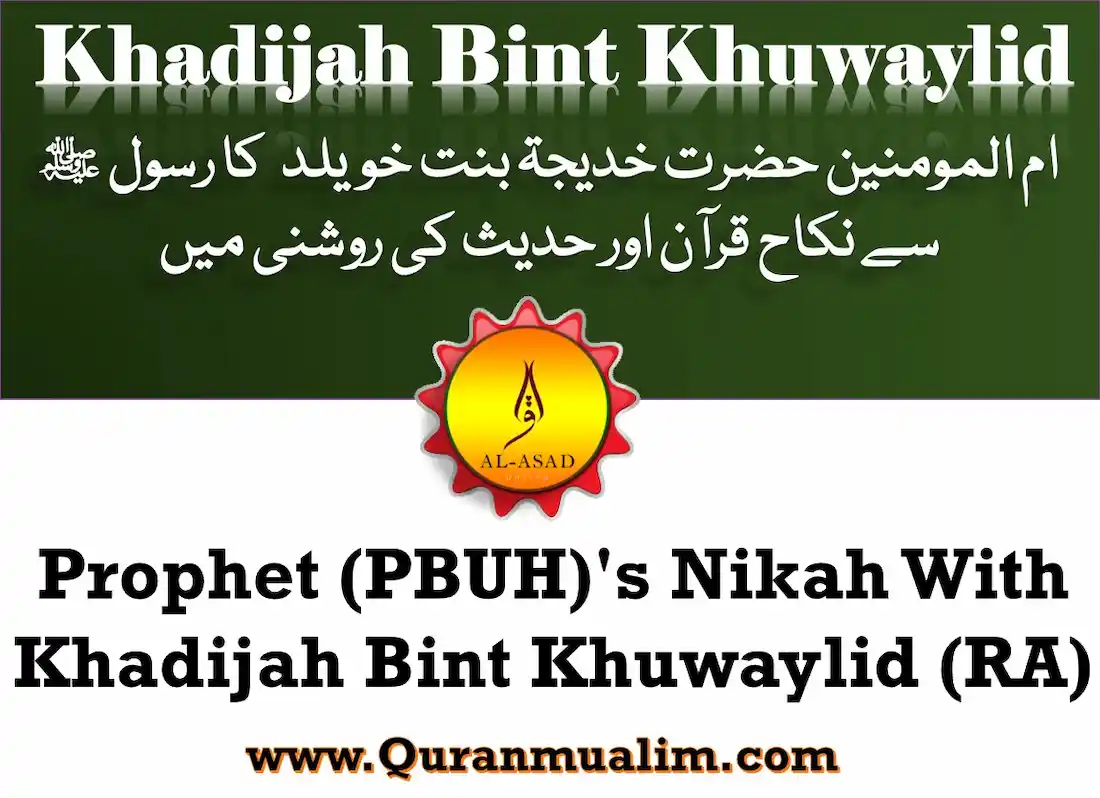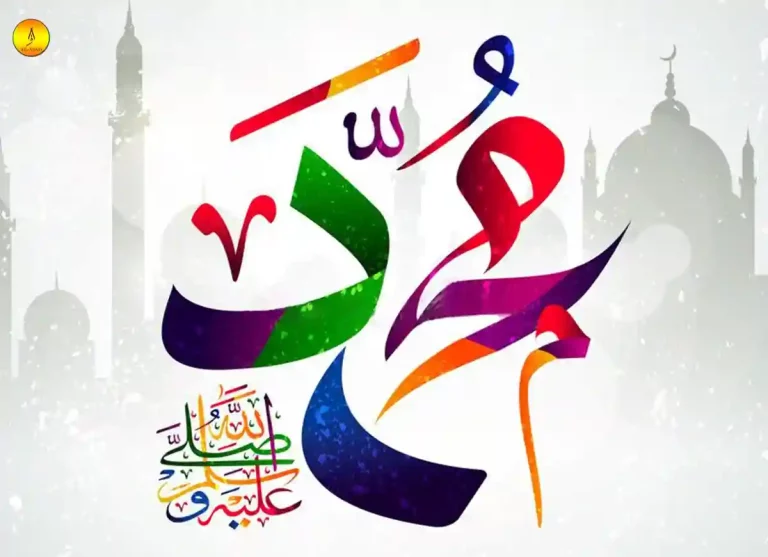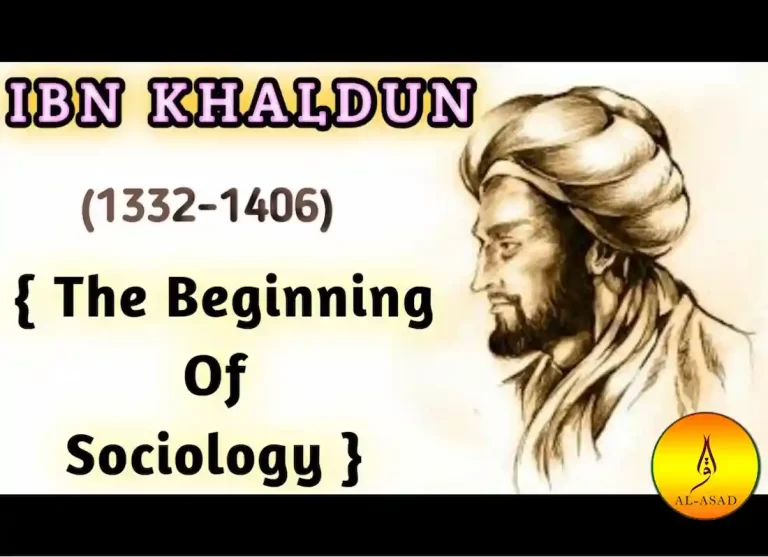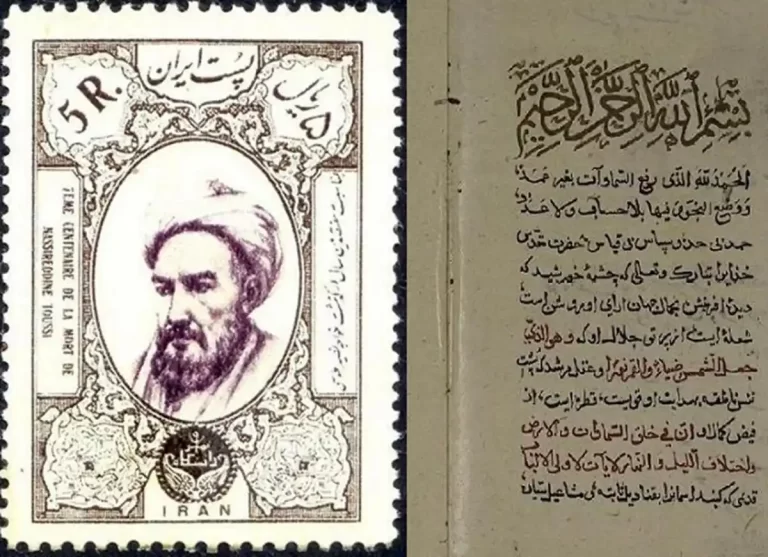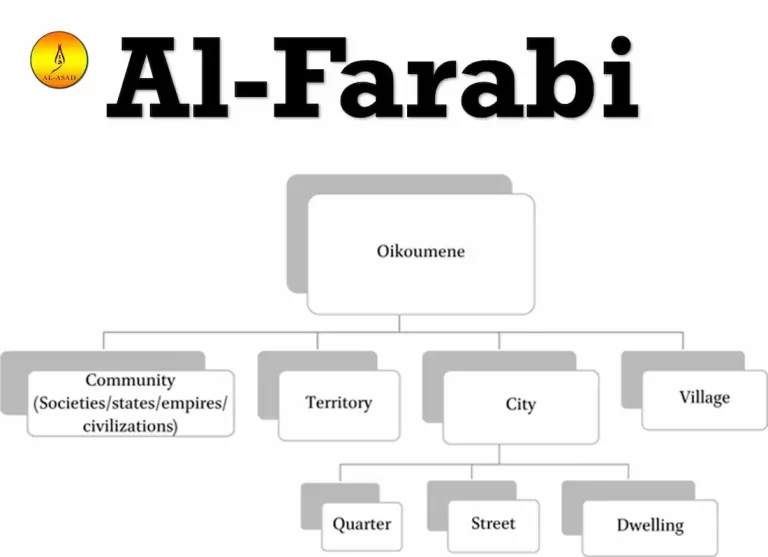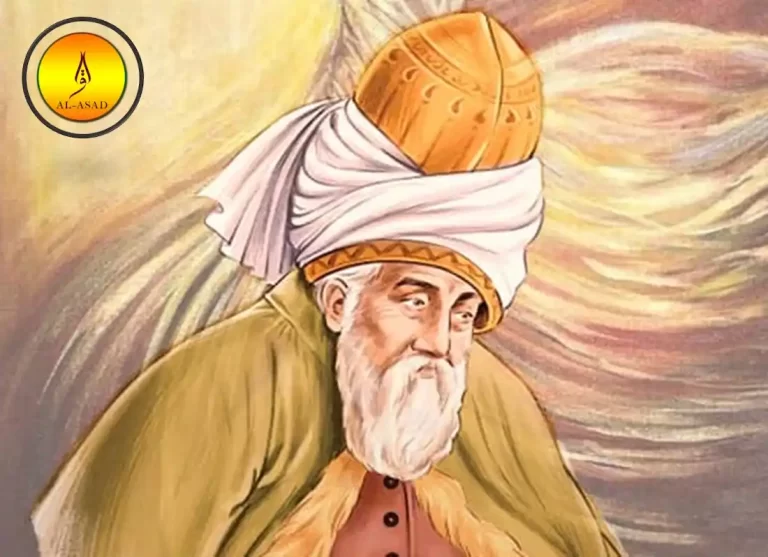Khadijah Bint Khuwaylid (رضي الله عنه) – If you are looking to learn more about details about the lives of the remarkable woman, and don’t have the 11 volumes of encyclopedias titled Bihar al-Anwar, the most reliable sources are Al-Sayyuti’s Tarikh al Khulafa and Abul-Faraj al- Isfahni’s book Aghani, The Ibn Hisham’s Seera, Muhammad Ishaq’s Seerat Rasool-Allah, as well as Tarikh Al-Rusulwal Muluk written by Abu Jafar Muhammad ibn Jarir al-Tabari (839-923 A.D.).
Suggested Read : How Many Chapters in Quran? ,la ilaha illa anta subhanaka, Has The Quran Been Changed?, How Many Pages in Quran? , Allahumma Ajirni Minan Naar, Allahu Mahdina, Allahu Alam , Allah Yashfeek , Allah Subhanahu Wa Ta’ala
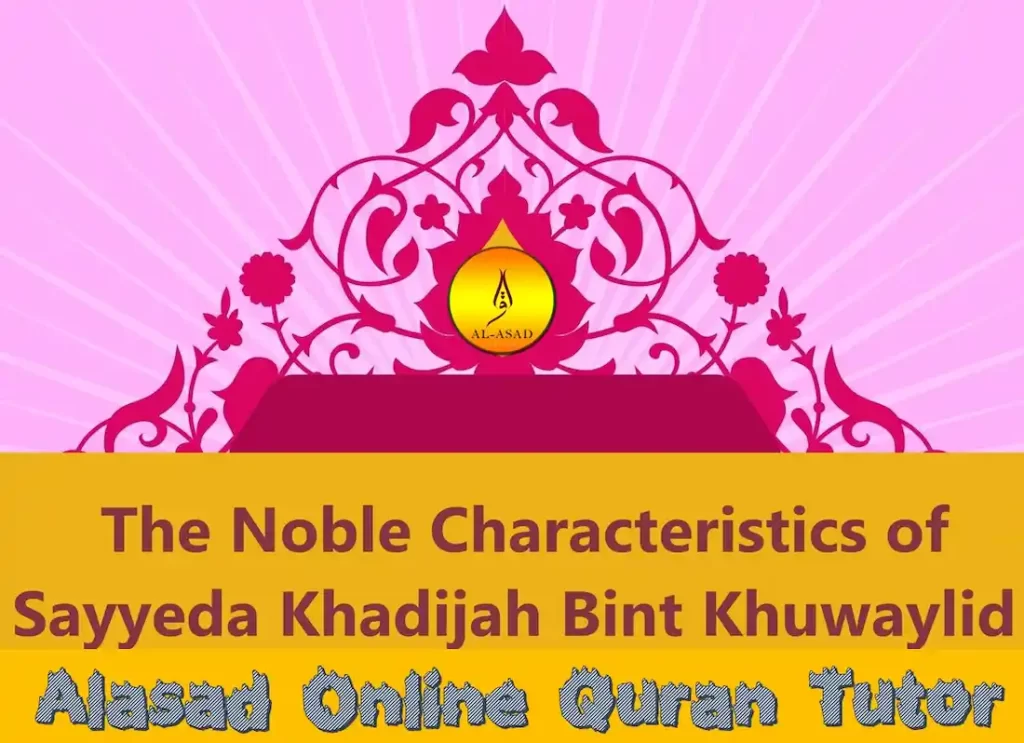
Khadijah Bint Khuwaylid (رضي الله عنه) – Of these the only one by the al-Tabari’s Tarikh is currently being translated (by multiple translators and in a number of volume) in English. One of the publishers of the Tabari’s Tarikh is the Press from the State University of New York (SUNY). This article is based on numerous Arabic as well as English references. It is specifically written for people who love the history of our greatest teacher, whether Muslims or not Muslims and those who wish to gain knowledge from it.
“Islam did not rise except through Ali’s sword and Khadijah’s wealth,” an old legend says. Khadijah al Kubra daughter of Khuwaylid Ibn (son of) Asad ibn Abdul-`Uzza ibn Qusayy was a member of her clan Banu Hashim from the clan of Banu Asad. The woman was the distant relative of her husband, the Messenger of Allah, Muhammad ibn Abdullah ibn Abdul-Muttalib Hashim who was bn Abd Manaf ibn Qusayy,
Allah’s peace and blessings to his descendants and the ones he has progenitors. Qusayy is the ancestral father of all clans that belong to Quraish. According to certain historians, Quraish’s actual name was Fahr and he was the son of Malik his father Madar Son of Kananah son of Khuzaimah Mudrikah’s son of Ilyas son of Mazar son of Nazar Maad the son of Adnan son of Ismael (Ishamel) father of Ibrahim (Abraham) son of Sam son of Noah Peace and blessings from Allah for the prophets his ancestors.
According to several sources Khadijah was born 565 A.D. and died in 620, aged of 55. However, some historians suggest that she died ten years later. Khadijah’s mother passed away around 575 A.D., was Fatima daughter of Za’ida Ibn al-Asam who was a member of Banu `Amir ibn Lu’ayy ibn Ghalib as well as a distant cousin of the Prophet Muhammad (S).
Khadijah’s father, who passed away about 585 A.D., belonged to the clan of Abd al-Uzza from the clan of Quraish. Like other Quraishis were, he was merchant and prosperous businessman whose immense fortune and business skills were passed on to Khadijah and with whom Khadijah did well in acquiring the wealth of his family. According to the legend, the Quraish trade caravans met to begin their long and difficult journey, either to Syria during summer or to Yemen in winter his caravan was equal to all the caravans of other traders from Quraish.
Rare photo of Khadijah’s 3 story house in which prophets () lived as well as Fatima () was born before its demolishment at the time of 1413 A.H./1992 A.D. by the Saudi government to increase the size of and expand the Sacred Haram housing the Ka’ba
The society where Khadijah was born was extremely male-centric, Khadijah was awarded two honorific titles, Ameerat Quraish Princess of Quraish in addition to at-Tahira The Pure One due to her exceptional personality and moral character in addition to her impeccable descent. She would help the poor and feed them as well as assist her family financially and even fund the wedding of her kin who might otherwise not have the means to get married.
the year 585 A.D., Khadijah was abandoned as an orphan. In spite of that, and having been married twice and losing her husband due to the devastating conflict in which Arabia was infected She was not in a hurry to get married again, even although she was sought out to marry by many reputable and respected men from the Arabian region, where she was well-known due to her business transactions.
She simply did not like the idea of losing her husband for the third time. The first man she married was “Abu (father of) Halah” which was Hind ibn Zar’ah who was a member of Banu Adiyy. The third was Ateeq ibn Aa’ith. Both were members of Banu Makhzoom. Through her first husband, she had one son called after the father of his mother, Hind. He also was later to become one of the most renowned Sahabis (companions to Muhammad, the Holy Prophet). He was a participant in both the combats at Badr and Uhud and is also well-known for his descriptions of the physique of the Prophet.
Hind was killed in The Battle of the Camel in which Hind was fighting on behalf to Imam Ali ibn Abu Talib (`), but some historians believe that he was killed in Basra. The majority of biographies describe Hind as a flamboyant orator as a man of piety and generosity, as well as one who exercised extreme caution when saying The Messenger from Allah (S). Alongside him Khadijah was also a mother to Abu Halah to two other sons, at-Tahir and, of course Halah who isn’t popular with historians, despite the fact that his father’s name is derived from his name.
Who were the children of Khadijah’s the second man she married? This is a different controversy that is centered around the other step-daughters or daughters from the Prophet (S) as well as Fatima (`). The girls, chronologically in order of chronological arrangement, are Zainab, Ruqayya, and Ummu Kulthoom. There are some historians who believe these were Khadijah’s daughters through her husband’s second, but others believe that they were daughters of Muhammad (S).
The first theory is argued by Sayyid Safdar Husain In his work the Early History of Islam where the author bases his conclusions on the content of the famous work by al-Sayyuti Tarikh al-Khulafa Muluk (history of caliphs as well as kings; be sure not to mistake it for Tabari’s Tarikh and both of them bear the same title and this isn’t uncommon in any way). We hope that a few among those of our Muslim daughters who are reading this article will be inspired to investigate the topic. Here’s a short account of Khadijah’s daughters.
Suggested Read: Travel Dua, Morning and Evening Duas, Ghusl Dua , Entering House Dua and Dua For Wake Up
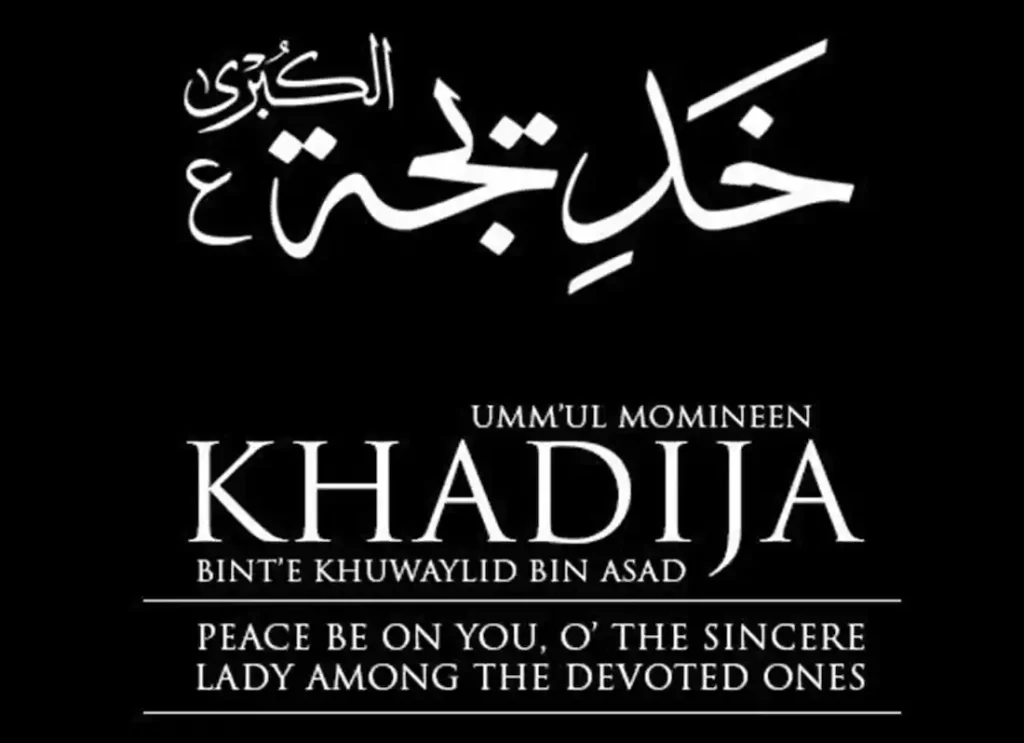
Khadijah Bint Khuwaylid (رضي الله عنه) – Zainab the oldest of their children was born prior to the prophetic mission , and had been married by Abul-`As ibn al- RabeeA. She was a convert to Islam prior to her husband’s acceptance, and was part of the movement to Mecca towards Medina. She passed away in early eight A.H. (630 A.D.) and was burial within Jannatul Baqee` where her grave remains and proving that time has not passed.
Ruqayya as well as Ummu Kulthoom married two of Abu Lahab’s sons. Abu Lahab, one of the eleven uncles of the Prophet was adamant and openly opposed to his nephew’s sermons. As a result his denial was found by the Mecci Chapter 111 of the Holy Qur’an, a chapter named in honor of his name.
When he learned of this admonition, he became angry and declared to his sons “There shall be no kinship between you and me unless you part with these daughters of Muhammed,” and they divorced them in a flash. Ruqayya got married to the third caliph Uthman Ibn `Affan and then emigrated with the caliph from Ethiopia at the age of the year 615 A.D., five years following the initiation of the prophetic ministry, and was accompanied by only nine other people. This was only the beginning of two journeys. After returning home, she passed away in Medina in the year 2 A.H. (624 A.D.) and was buried in Jannatul Baqee`.
Uthman got married to her sister, Ummu Kulthoom, in Rabial-Awwal, the next (third) Hijri year (September of 624 A.D.). Ummu Kulthoom lived with her husband for approximately six years, before she died at the age of the year 9 A.H. (630 A.D.) and left no children. Certain Muslims have a different version of the story and claim that, even though Khadijah was a lot more advanced than Prophet () however, she was still an unmarried woman …, and Allah knows.
The Muslims are informed that the Prophet had only one wife who was virginal Lady ‘Aisha who was the daughter of the caliph who was first Abu Bakr. The other wives were also married. What’s wrong with this? The Prophet Sulayman (Solomon) got married to an unmarried woman as did many Prophets, messengers, and prophets from Allah.
A particular characteristic of Khadijah that was fascinating and probably more interesting than the other characteristics that were mentioned earlier the fact that she was not like her people. She never worshipped or believed in idols. There was a small amount of Christians and Jews resided in Mecca at the time , and there was a significant number of Jews resided in Medina in fortified communities big and small, with the largest of which was Khaybar.
Waraqah ibn Nawfalwas one of the Khadijah’s relatives (some claim he may have been her Uncle) was a convert to Christianity and was also a reverent monastery monk, who was a believer in the Oneness of the Almighty like the majority of early Christians believed, which is, prior to the idea of the Trinity was incorporated into Christian faith, causing philosophical differences among followers of Christ (`).
We will pause here for a moment , and attempt to trace the history all the way back to the moment when the Trinity was made “officially” a tenet of the Christian faith. It is true that the only Christian Gospel that is accepted by Muslims as authentic, true and unaffected by deformation is the Gospel from St. Barnabas, a Cypriot associate to St. Paul (originally Saul) and was not canonized at the Council of Nicaea of 325 A.D. where the Trinity was integrated into Christian faith for the very first time. This was in the fourth century following Christ!
For more than 400 years, not many of the Christians were aware of the Trinity. The Council of Nicaea, which was in fact a snub by numerous Christian congregations across the world and was pushed by the Byzantine Emperor Constantine I (288 – 337 A.D.), or Constantine the Great, who constructed the present-day Turkish city of Constantinople in the year 330 A.D. to dedicate it to Jesus Mother, the Mary. Mary.
Constantine’s motive behind his Nicaea Conference was to settle the differences between various Christian sects on what constitutes Christianity and what didn’t and the Conference resulted in more problems than it resolved. It was opposed by several Christian sects who did not support its resolutions.
We will now go back to Waraqah Ibn Nawfal. The scholar was said to have written his work in the Bible from Hebrew to Arabic. His works could be measured on one hand during the time of the metropolis that was populated by millions of people. Mecca or Becca also known as the city of Ummul-Qura (the city that was the mother of all towns) which was a major commercial city at the intersection of trade caravans that linked Arabia to India, Persia, China and Byzantium the city with it’s very own Red Sea port at Shu`ayba which facilitated trade and commerce in it.

Khadijah Bint Khuwaylid (رضي الله عنه) – In addition, Mecca contained the Kaba which is the cubic “House of God” which is always sought after to be a place of pilgrimage. It was once circumscribed in the naked hands of Polytheist “pilgrims” who kept their idols, with 360 of them large and small female and male in the roof. One of them was dedicated to Abraham and one for Ishmael with divine arrows in his hand. Hubal is a massive idol that was shaped like man, was offered as a gift from the Moabites of Syria to the tribesmen of Khuza`ah and was Mecca’s main idol.
The other two idols that were significant were the ones of Lat which is a gray granite statue that was the goddess of females from Thaqif, the clan of Thaqif near Taif and the Uzza which was also which was a female god made from a granite block around twenty feet long.
They were believed to be the wives of Allah… Every tribe had their own god and the wealthy purchased and kept several idols in their homes. The institution of pilgrimage was in place however it wasn’t being properly observed and neither was the faith in Allah who the Arabs believed was their supreme or primary god. In addition to Paganism, different “religions” in Arabia included idolatry and star worship.
It was believed that the Jews of Medina had moved to Palestine and settled in Medina, in anticipation of the arrival of the new prophet, derived from Abraham’s seed. Abraham () who, they claimed, they were going to be believers and the first to follow however this didn’t happen; on contrary, they allied with the pagans to combat the spreading of Islam.
There were a few who accepted Islam as well as one man who was a neighbour to Muhammad (S) and lived in the same street in Mecca the place where Khadijah’s home stood and his wife, who was also Jewish was known to gather dry thorny bushes in the desert, only to throw them into the path of the Prophet.
Because Khadijah didn’t travel in her trade caravans and was not able to travel with her trade caravans, she had to rely on another to be her agent for trading on her behalf and get a agreed-upon commission as a reward. At the time of 595 A.D.,
Khadijah needed an agent who could trade her products that was headed to Syria and that was when several agents she knew and trusted before along with her own family members including Abu Talib, suggested to her to hire her cousin who was distant from her, Muhammad ibn Abdullah (S). In the year 595 the Muhammad (S) was a young man. Muhammad (S) has already been granted the honorific title of As-Sadiq, who was the honest, and al-Amin, the reliable.
Muhammad (S) was not able to have any business experience in the real world However, he twice been with his uncle, Abu Talib, on his trade excursions and was keenly watching the way he bartered, traded as well as bought and sold items and managed business. The people of Quraish were well-known for their involvement in trading more than any other occupation. It was commonplace to recruit an agent who didn’t have prior experience, so, Khadijah decided offer Muhammad (S) an opportunity. He was only 25 years old. young.
Khadijah She sent Muhammad (S) message via Khazimah ibn Hakimwho was one of her close relatives offering him twice the commission than she normally allowed her agents to trade for her. She also provided him with one of her staff members, Maysarah, who was young, smart and gifted to work with him in his bookkeeping. She also trusted the account of Maysarah about her new employee’s behavior the account of which was glaring and one that prompted her to give up on her desire not to get married again.
Before setting out on his first journey as a businessman for Khadijah, Muhammad (S) visited his uncles for final meetings and briefings, after which he took off on the desert route, passing across Wadi al-Qura Midian as well as Diyar Thamud areas where he was acquainted due to being there when he was twelve, in the company of his uncle Abu Talib, father of his cousin, and later son-in-law Ali ().
The long journey continued until he reached Busra (or Bostra) on the road leading to the old city of Damascus in about a month. The city was at that time the capital city of Hawran and was part of the southeastern regions within the Province of Damascus located to the north of Balqa’.
For those who study classic literature Hawran is referred to for the Greek name Auranitis and is extensively described by Yaqut al-Hamawi Abul-Faraj al-Isfahani, and others. Arab trade caravans would travel frequently to Hawran, and sometimes further into Damascus and Gaza but only a few reached across Mediterranean shores to take off their treasured loads of Chinese silk and paper to be shipped off to Europe.
What were the items Muhammad (S) bring on his journey to Busra and what did he purchase from there? Meccans weren’t considered as skilled craftsmen and they were not awe-inspiring in any trade. But the young Muhammad (S) could carry an assortment of raisins, hides, perfumes, dried dates lighter weight woven products likely silver bars and probably some plants. He would have bought whatever was ordered by his boss to buy such items could be manufactured products and clothing, as well as a few expensive items that he could offer to the wealthy Meccans as well as certain household items.
Silver and gold coins used by the people of Mecca include Roman, Persian, and Indian coins. Arabs at the time and even those far more sophisticated than ones with whom Muhammad (S) was raised like the Arabs of the southern regions of Arabia (Yemen, Hadramout, etc. ) They had no separate currency and therefore barter was more prevalent than cash. It was the first Arab Islamic currency, by the way, was created at Damascus during the time of the Umayyad leader Abd al-Malik ibn Marwan (697-698 A.D.) in 78 A.H. (697 A.D.) 36 years after the creation in the Umayyad dynasty (661-750).

Khadijah Bint Khuwaylid (رضي الله عنه) – The period Muhammad () was in Busra was just one or two months, during which he hung out with a variety of Christians as well as Jews and noted the differences in theology between the most prominent Christian sects, which led to the separation of the Copts and The Syrian (Chaldean) Nestorian, and the Armenian Christians from the main churches of Antioch (Antakiya), Rome along with Egyptian Alexandria.
Dissensions, disagreements, and theological views gave Muhammad (S) with ample food for thought He pondered these issues often. He was once observed in the presence of Nestor the monk, who was sitting under the tree while caravans walked through the outer reaches of Busra close to the monastery of the monk.
“Who is the man beneath that tree?” asked Nestor in Maysarah. “A man of Quraish,” Maysarah replied and added “of the people [the Hashemites] who have guardianship of the Sanctuary (the Ka’ba).” “None other than a Prophet is sitting beneath that tree,” said Nestor who was observing some of the signs of Prophethood Two angels (or as per other reports, two cloud formations) shaded Muhammad (S) against the scorching sun’s heat. “Is there a glow, a slight redness, around his eyes that never parts with him?” Nestor was able to ask Maysarah. If she replied with a positive affirmation, Nestor said, “He most surely is the very last Prophet; congratulations to whoever believes in him.”
One of the things that Muhammad observed while during his stay in that Syrian town was that of the fact that there was a war in the midst among two empires, the Persian as well as the Roman empires, both battling to claim the Arabian crescent. In fact, this observation was quite true in that, after just few years, conflict broke out between the most powerful nations of the time which ended with the Romans losing the war according to according to the Holy Qur’an tells us in Chapter 30 (The Romans), that was revealed at the 7th year of A.H./615-16 A.D.,
only two months after the defeat of Jerusalem to the Persians and then winning again in the next one. Four years prior to the date of the revelation it was reported that the Persians had enjoyed a huge victory over Christians and had expanded their power on Aleppo, Antioch, and even Damascus. Muhammad (S) is worried about either one of these empires expanding its power over the land inhabited Muhammad’s extremely free Pagan people.
The demise of Jerusalem which was the place of birth for Christ, Jesus son of Mary (`), was devastating to the esteem of Christianity. The majority of Persians were at the time adhering to Zoroastrianism, a creed which was first introduced during the sixth century prior to Christ through Zoroaster (628-551 B.C. ) which is also called Zarathustra and whose followers are described as followers who worship”the “pyre,” the holy fire. “Persia,” hence, is “the land of the worshippers of the pyre, the sacred fire.”
Present-day Iran was previously described as “Aryana,” land of the Aryan tribes and nations. This was not just for Iranians as well as Kurds and Germans who were proud of being Anglo-Aryans (Caucasian) Nordics or people who spoke an Indo-European dialect. Certain Persians were converted to Christianity according to Salman al-Farisi, one of them until the time he was captured, being sold in Mecca and then released to become an one of the world’s most revered and revered Sahabis and the narrators of hadith in Islamic history, so to the point it was said that the prophet of Islam (S) stated, “Salman is one of us, we Ahl al-Bayt (People of the Household of Prophethood).”
The war mentioned earlier was fought between the Byzantine (Eastern roman) the emperor Heraclius (575 641 – 575 A.D.) and the Persian King Khusrau (Khosrow) Parwiz (Parviz) or Chosroes II (d. 628 A.D.). It was just one of the numerous wars in which these powerful nations were involved and fought for years. However, God’s hands Divine Providence were already busy creating the way towards Islam The clash between the two empires opened the way to the ultimate destruction of the old Persian empire, and also for Islam becoming a reality in this crucial region of the globe.
In addition that, Muhammad’s (and Khadijah’s) offspring got married to women who were raised and born in Persian and Roman palaces. The Imam Husain ibn Ali ibn Abu Talib (`), Muhammad’s grandson, who is also our third Holy Imam, got married to with the daughter of late Persian Emperor Jazdagird (Yazdegerd) III, the son of Shahryar and grandson of the similar Khusrau II. Jazdagerd reigned over Persia between 632 and 651 A.D. and lost the Battle of Qadisiyya to Muslim army in 636.
This ended the rule of 427 years by the Sassanians, which lasted from the year 224 A.D. to 651 A.D. After being defeated by the Muslim forces, he fled to Media located in northern Iran the home of the Persian Mede tribesmen, and from there, he went to Merv the ancient Central Asian city near modern present day Mary within Turkmenistan (until the very recent days, one among the republics in the Soviet Union), where he was murdered by miller. The emperor’s death left two daughters behind who, when they tried to escape after being killed by their fathers were snatched and were sold as slaves.
The one who was named Shah-Zenan was the one who got married to our Third Most Holy Imam Husain ibn Ali ibn Abu Talib (`), while her sister was married to the famous scholar and well-known muhaddith(traditionist) Muhammad son of the first Muslim caliph Abu Bakr.
Shah-Zenan received the title of a king and given a new title in her native Persian mother language: Shahr Banu, which refers to “mistress of the ladies of the city.” The marriage she had with Imam Husain () created our fourth Holy Imam (Zainul-Abidin also known as al-Sajjad) Ali ibn al-Husain ibn Ali ibn Abu Talib (`).
The earnings Khadijah made from this trip were two times more than she expected. Maysarah was more intrigued in the case of Muhammad (S) more than everything else connected to the trip. Muhammad (S) however, in contrast returned with his impressions of what he’d seen and heard, impressions that was shared with his employer. The reason is that these trade caravans were the sole connections that contemporary Arabs had with the outside world. They carried information about what was happening outside their famine-ridden desert and Sand dunes.
Waraqah ibn Nawfal, just like Bahirah was the monastery monk that saw and talked with Muhammad (S) at the time that Muhammad (S) was an adolescent, belonged to the Nestorian Christian sect. He was informed of the character and behavior of the young Muhammad (S) through Khadijah, his cousin, and her servant Maysarah the account of which led him to sit for a long time and contemplate what he’d read.
He raised his head and told Khadijah “Such manners are fit only for the messengers of God. Who knows? Maybe this young man is destined to be one of them.” This assertion was confirmed couple of years later. Waraqah was the first person to recognize Muhammad (S) as the Messenger of Allah shortly upon hearing that Muhammad (S) got the first revelation in Hira cave.
The trip’s success inspired Khadijah to hire Muhammad (S) for a second time on his winter journey to south Arabia, i.e. Yemen which is the country which brought coffee bean to all the nations. It was also the land in which the world-renowned Ma’rib irrigation dam was built in the land that was home to Saba’ and the renown Balqees Balqees, the Arabian queen from Sheba (Saba’) of Himyar who got married to the King Solomon (Sulayman The wise peace be with the wise) around 975 B.C. (after finishing the work on the famed Solomon’s Temple)
The land of indigenous people adept at silver, gold and other metal crafts and their creativity with regard to textiles as well as furniture in the home …, and may even be the place which introduced Arabic its first script written in the alphabet, which is believed by some to was based on written Amheric that was later the official language of Ethiopia along with its colonies.
Yemen at the at the time, was run by an Ethiopian regent. Khadijah, at the time, offered Muhammad (S) more than the normal commission. The problem is that historians do not provide much information about this second visit, except that it was profitable for both employers and employees. Some historians do not even mention the trip in any way.
Khadijah was then convinced she had found a man suitable for her so much that she proposed an engagement proposal of her own. Muhammad (S) would go over all the business transactions with which the he was involved on her behalf, however the rich and beautiful woman of Quraish was more thinking about her cousin’s distant relatives rather than the transactions.
The girl simply fell to love Muhammad (S) in the same way that was the child of Arabian prophet Shuayb was in love with the then exiled prophet Moses () according to the verses from the verses 28:25-26 in the Holy Qur’an (in Surat al-Qasas). Muhammad (S) had a body tall and medium-sized, inclining towards slimness, sporting the largest head with broad shoulders, and other parts of his body was perfectly proportioned. His beard and hair were dark and dense although not completely straight, they were slightly curled. His hair was about halfway between the lobes of his ear and shoulders, while his beard had a length to match.
He had a regal width of his forehead. The ovals of his eyes were broad with long, long lashes and long brows, lightly arched, but not connected. The eyes of his were believed to be black however, other sources say they were brown or some say they were light brown. The nose of his was aquiline, as well as his lips well formed.
While he allowed his beard to grow, he did not allow the moustache’s hair to extend over the top of his lips. His skin was light, but was tanned by the sun. There was a glow in his eyes, an glowing similar to the light that was shining from his father’s eyes, but it was much more intense and was visible on his large forehead and around his eyes that were extremely luminescent.
At the point his departure Khadijah sought advice of a close friend of hers, named Nufaysa child of Umayyah. She offered to speak with him on behalf of her and, if it was possible organize a marriage between them. Nufaysa was approached by Muhammad (S) in the morning and inquired about why he had not yet gotten married.
“I have no means to marry,” Muhammad (S) replied. “But if you were given the means,” she declared, “and if you were bidden to an alliance where there is beauty, wealth, nobility and abundance, would you not then consent?!” “Who is she?!” He asked excitedly. “Khadijah,” said Nufaysa. “And how could such a marriage be mine?!” He asked. “Leave that to me!” was her reply. “For my part,” he replied, “I am willing.” Nufaysa came back with joyous news to Khadijah, who made a call of Muhammad (S) to ask for him to visit her. As he arrived she told him:
O my uncle’s son! I cherish your kinship to me and the fact being always at the middle, and not an ardent partisan to support this or this or that. I also love you for your reliability, as well as for the quality of your personality and the truthfulness of your words.
She then offered her marriage to him and they decided that he would be able to speak to his uncles and she would talk with her grandfather, Amr son of Asad because her father had passed away. It was Hamzah even though he was young, that was the Hashemites were entrusted to serve as their representative at this wedding ceremony because he was closely connected to them via their clan Asad and his sibling, Safiyya, had just got married to Khadijah’s brother Awwam. This was Abu Talib, Muhammad’s uncle who gave the wedding sermon. He said,
All praise goes to Allah Who made us the descendants from Ibrahim (Abraham) and the Ismael’s seed (Ishmael) and Maad’s descendants, the essence of Mudar and who created us as the custodians of His House as well as the servants of the sacred places creating for us a place that is a place of pilgrimage as well as an abode of security as well as giving us the power to rule over the masses.
My nephew, Muhammad (S), is not comparable to anyone else: If you look at his wealth to the wealth of other people it is impossible to be able to identify him as a person of money, as wealth is a shadow that disappears and is a fickle thing. Muhammad (S) has an individual whose family tree is well-known and has sought Khadijah the daughter of Khuwaylid to marry, and offered her something of my dower from my personal wealth.
Nawfal stood up and said:
Khadijah Bint Khuwaylid (رضي الله عنه) – The entire praise belongs to Allah who has made us exactly as you’ve stated and favored us over others you’ve mentioned, because we are the supreme masters of Arabs and their leaders and you all are deserving from the honor of this (bond to marry). This tribe (Quraish) doesn’t deny any of your accomplishments or the merits of anyone else. doubt your awe-inspiring position and status. We, too, would like to join your tether; therefore take note of my words to the members of Quraish! I have gifted Khadijah, girl from Khuwaylid for marriage Muhammad ibn Abdullah for the dower of four hundred dinars.
Then Nawfal was silent, and Abu Talib said to him, “I wished her uncle had joined you (in making this statement).” After hearing this, Khadijah’s uncle stood and declared, “Bear witness, O men of Quraish, that I have given Khadijah daughter of Khuwaylid in marriage to Muhammad ibn Abdullah.”
The details of this and many more are revealed in the Ibn Hisham’s Seera. After his wedding, Muhammad (S) moved from his uncle’s home to stay alongside his bride in their home which was situated at the smiths’ market an alley that was a part of Mecca’s main bazaar. It was located behind the Masa which is where pilgrims make the seven-circles in the hajj or umra.

Khadijah Bint Khuwaylid (رضي الله عنه) – In this home Fatima (Fatima () was born, and the revelation fell upon The Messenger of Allah (S) several times. The house, as well that the one where Muhammad (S) the prophet of Islam (S) was born (which stood about 50 meters to the north) was both destroyed by the fanatical and ignorant Wahhabi ruling class from Saudi Arabia in 1413 A.H./1993 A.D …. The grave sites of a variety of relatives and friends belonging to The Holy Prophet (S) were all destroyed in the hands of the Wahhabis during 1343 A.H./1924 A.D. against the will and even despite the condemnation of the adherents to the different Muslim sects and the various schools of thought around the world.
The wedding was a joyful one, and resulted in a woman who was among the four women who were perfect in the history of the world: Fatima daughter of Muhammad (S). Prior to the marriage, Qasim and Abdullah were born, however they both passed away at infancy.By when Khadijah became married, she had become wealthy who was so rich that she did not feel the need to continue trading or expanding her wealth. Instead she decided to retire and lead the comforts of living with her beloved husband, who preferred an ascetic lifestyle. would rather live a life of asceticism than one of making money.
Allah (S) was the Messenger. Allah (S) was not a person with a desire to acquire wealth. It was not the reason to which He blessed peace and peace of Allah with his progenitors was created. He was made to save humanity from the darkness of ignorance, idolatry polytheism, miserable, inequity, poverty, oppression and moral lapses. He was very fond of meditate, but his practice intensified his sorrow at seeing the state of his society sinking in moral sexism, lawlessness and the lack of any kind of protection for the vulnerable and marginalized.
Khadijah’s happy time lasted not more than 15 years, after which her husband, who is now known as the Messenger of Allah (S) has begun his mission of bringing all people into be a part of the Oneness of God and to the equality of females and males and to put end the evils of our time. Muhammad (S) had been forty-years-old at the time the Quran’s first words were given to him.
These were the first verses in Surat al-Alq (chapter 96) which were revealed in the period of Ramadan 13 years prior to the Hijra in the cave known as Hira within Jabal al-Noor (the mountain of light) the place he preferred to meditate and be alone and is now frequented by a number of pilgrims. Muhammad (S) returned home astonished, deeply perplexed amazed by the appearance of the Gabriel, the arch-angel Gabriel and the profundity of meaning he found in these gorgeous words:
In the Name of Allah, the Most Gracious, the Most Merciful
Khadijah Bint Khuwaylid (رضي الله عنه) – Proclaim (or read)! In the name God, your Cherisher and Lord who made (everything). (He) designed man from the (mere) congealed blood. Proclaim! Your Lord is Most Merciful One who taught (the the use to use) Pen, who taught man what did not know… (Qur’an, 1-5, 96:1-5)
He was feeling ill, so the patient asked for a wrap and, after feeling better, he recounted what he’d seen as well as heard back to his loyal and loyal wife.
“By Allah,” Khadijah declared, “Allah shall never subject you to any humiliation, …, because you keep your connections with the people of your relatives and you’re generous with your gifts. You’re a diligent person and seek out the things that others consider impossible. You are able to sway your guests and give your help to those seeking justice and justice. Be strong, my dear friend because by Allah I am certain that Allah will not handle your case except in the most beautiful way and I swear your status as the long-awaited Prophet of this nation and your time is, if Allah wills, is now here.”
After a brief time Khadijah informed her husband of the predictions of Buhayra, the Syrian monk Buhayra about Muhammed’s Prophethood and also about her conversation with her servant Maysarah who informed her about the things that Bahirah (or Buhayrah) had spoken of, as well as in her relationship with her uncle Waraqah Ibn Nawfal.
Then, she accompanied her husband back to Waraqah’s residence to tell the story of the incident. “Let me hear it in your own words,” Nawfal told Muhammad (S) in addition to, “O noble master!” When he heard the Prophet’s words Nawfal sat down to pick his words careful; he stated “By Allah, this is the prediction which had been conveyed to Moses (`) and with which the Children of Israel are familiar! [Moses] had said: `O how I wish I could be present when Muhammad (S) is delegated with Prophethood to support his mission and to assist him!'”
Dome over Khadijah’s tomb before it was destroyed to be used by Wahhabis from Saudi Arabia
It was only normal for Khadijah to be the victim of her fair share of the shaming that he was subjected to by no one other than the people who, in the past used to refer to him as Al-Amin, as-Sadiq. Khadijah was not hesitant to adopt Islam even though she knew that her husband was not able to make a false assertion.
Yahya ibn `Afeef is quoted as saying that he had visited, in the jahiliyya (the period prior to the beginning of Islam) in Mecca for a meal hosted by Al-Abbas Abdul-Muttalib one of the uncles of the Prophet mentioned above. “When the sun started rising,” says the Prophet, “I saw a man who emerged from an area not too far from us, walked towards the Kaba and began performing his prayers.
He barely got started when he was joined by a small boy who was standing at his side and followed by a woman behind them. When he bows to the young boy, both the woman also bowed. And when he stood straight, they also, did the same. When the latter prostrated, they too, bowed.
” Then , he was amazed at the sight and said to al-Abbas: “This is quite strange Abbas! Abbas!” “Is it, really?” Al-Abbas responded. “Do you know who he is?” al-Abbas asked his guest , who responded with a negative. “He is Muhammadibn Abdullah, my nephew. Do you know who the young boy is?” asked the guest. “No, indeed,” replied the guest. “He is Ali son of Abu Talib. Do you know who the woman is?
” The same answer was given in the negative. al-Abbas replied, “She is Khadijah daughter of Khuwaylid, my nephew’s wife.” The incident is mentioned in the writings of Imam Ahmad and al-Tirmithi, each of them describing it in their individual Sahih book. She remained patient when she was subjected to oppression to which her revered husband and his tiny group of believers were slain by the aristocrats and polytheists of Quraish as she sacrificed her immense fortune to spread Islam and seeking Allah’s blessing.
The most notable of her accomplishments was being among the four exquisite women and the three others being: Fatima (`) daughter of Muhammad (S), Maryam bint Umran (Mary child of Amram) and mom of Christ (`) and niece of prophet Zakariyya (Zacharias) and Ishba (Elizabeth) as well as Asiya, daughter of Muzahim and the wife of Pharaoh. Prophet Zakariyya is, as everyone is aware is the father of Yahya (John the Baptist) The later being just one month older than the prophet Jesus (`).
The prophet of Islam (S) often discuss Khadijah frequently following her death and so his wife’s youngest daughter, Ayisha daughter of Abu Bakr felt very insecure when he said: “… She was just an old woman with red eyes. Allah is compensating you by giving you a superior as well as a younger woman (meaning her).
” This made him (S) to become extremely angry, and he stated, “No, indeed; He has not compensated me with someone better than her. She believed in me when all others disbelieved; she held me truthful when others called me a liar; she sheltered me when others abandoned me; she comforted me when others shunned me; and Allah granted me children by her while depriving me of children by other women.”
Imam Ahmad ibn Hanbal, Abu Hatim Al-Dulabi, al Tabari and many more, all are quoted by Ayisha in saying that: “One day, the Messenger of Allah (S) mentioned Khadijah affectionately, so I was carried away by jealousy and said about her what I should not have said. It was then that his face changed color in a way I never saw it change except when he (S) was receiving revelation, so I realized what I had done and felt overwhelmed by regret to the extent that I could not help uttering these words: `O Lord! If You remove the anger of Your Messenger right now, I pledge not to ever speak ill of her as long as I live.’ Having seen that, he forgave me and narrated to me some of her merits.”
It is believed that both Muslim and Bukhari mention within their own Sahih books that one of Khadijah’s strengths was she was the Lord of Dignity instructed Jibraeel (Gabriel) to be at in peace, express his regards to her. Gabriel told Muhammad (S): “O Muhammed! Khadijah is bringing you a bowl of food; when she comes to you, tell her that her Lord greets her, and convey my greeting, too, to her.” After Muhammad (S) did this she responded: “O Allah! You are the Peace, and is the source of all peace, to you peace returns, Praised and Exalted are You, O One with the Greatness and Honor, and may with Gabriel be peace.”
Lord! You are peace! from you comes the peace and you return the peace. Praise and exalted are You O God of all the glory and honor.
Khadijah Bint Khuwaylid (رضي الله عنه) – Khadijah passed away from an illness of fever , on the eleventh or tenth day in the month Ramadan 10 years after the commencement of the Prophetic mission (in the year 619 A.D.), 24 years after her wedding with Muhammad (S) and was buried in Hajun in the outer reaches of Mecca. Prophet Muhammad (S) Allah (S) laid her body to rest and then buried her… Prayers for funerals ( salat al janaza) weren’t yet been prescribed in Islam. It was reported that when she died all her fortune was already spent to spread Islam She left neither any gold dinar or any silver dirham nor any other thing more or less…
O soul who is in peace! Rejoice in your Lord, who is pleased (with Him) with Him, and pleasing (Him) and so, go with My servants and go to My gardens. (Qur’an 29:27-30)
(This document on Khadijah al-Kubra and the Almighty bless her in the name of all the Muslim family from the very beginning to the end was written and circulated widely by me, the writer of the book, the 12th of May 1994 while I lived at Falls Church, Virginia, U.S.A. You are free to distribute it or put it on your web site, so that you can receive benefits from the Almighty Who is a lover of scholars and scholars as well as those who share information about His Messengers and Prophets, peace and blessings to all of them.)
Lessons to Learn
- The Holy Prophet (P.B.U.H) was married to her, despite being widowed divorcee, divorcee and an elderly woman. He never even thought about these qualities of her.
- When they got married, wedding, Khadijah was an entrepreneur, and Prophet was still not financially stable however Khadijah doesn’t seem to raise a fuss about this as she was impressed by his exemplary character and integrity.
- Following the demise of Khadijah The Holy Prophet was awestruck by her presence in front of his wives. He also had a great respect for Khadijah’s companion.
- She never spoke of discomfort during the economic crisis , and stood with the Prophet in his support of his mission.
- She would give her 50% of her profits to reward her top managers.
- She donated her wealth on the poor and the needy. She was known to treat sick people, look after orphans, and even arrange marriages for the girls who were poor.
- She was a perfect wife and mother.
- In her lifetime, Muhammad had no other wives.
To Wrap it Up
Khadijah Bint Khuwaylid (رضي الله عنه) – Islam is a total religion, and it is a complete religion and the Sahabiyat are the most important role models for humanity. We could solve the majority of our problems by following in the example of greats such as Khadijah Bint Khwaylid (R.A). She has debunked the many myths floating in the media these days. May Allah help us to follow to the right way. Ameen
Suggested Read: Dua Leaving House, Dua of Forgiveness, Dua of Taraweeh, Dua of Musa Alayhi’salam, Dua For Success, Dua For Marriage , Dua For Rain, Dua For Parents, Powerful Dua and Dua For The Sick
Questions and Answers
- 1.
- Lady Khadija (sa) was born in?
- A.
- Makkah
- B.
- Medina
- C.
- Yemen
- D.
- Hijaz
- 2.
- Is the Lady’s name Lady Khadija’s (sa) father?
- A.
- Khuwayled bin Assad
- B.
- Assad bin Abdul Uzza
- C.
- Abdul Uzza bin Qusayy
- D.
- Qusayy
- 3.
- Lady Khadija (sa) was born from the following Arab clan and tribe at the time:
- A.
- Quraysh (Banu Assad)
- B.
- Banu Kinanah
- C.
- Banu Hilal
- D.
- Banu Tamm
- 4.
- Name the person from the family tree that belong to the Prophet Muhammad (pbuh) as well as Lady Khadija (sa) from whom they divided (common progenitors of both)
- A.
- Munaf
- B.
- Fihr
- C.
- Assad
- D.
- Qusayy
- 5.
What faith Did Lady Khadija (sa) adhere to before she got wed to the Prophet Muhammad (pbuh)?
- A.
- No Religion
- B.
- Judiasm
- C.
- Hanifs
- D.
- Zoroastrianism
- 6.
- The grandparents of Lady Khadija (sa) pass away?
- A.
- Father 585AD, Mother 575 AD
- B.
- Father 575 AD, Mother 585 AD
- C.
- Both 575 AD
- 7.
Who was Waraqa bin Naufal ? And what was his relationship with Lady Khadija (sa)?
- A.
- Uncle
- B.
- Cousin
- C.
- Servant
- D.
- None of the above
- 8.
- The titles that were given to Lady Khadija (sa) prior to the her emergence into Islam and her marriage to Muhammad (pbuh) the prophet Muhammad (pbuh) during the days of Jahliya were (more than one answer):
- A.
- Princess of Quraysh
- B.
- Princess of Makkah
- C.
- The merchant from Arab
- D.
- Lady of Hijaz
- E.
- Tahira
- 9.
How long ago Did Lady Khadija (sa) choose to appoint Holy Prophet as her agent in the trade caravan?
- A.
- 565 AD
- B.
- 600 AD
- C.
- 595 AD
- 10.
- Choose the servant of Sayyida Khadijat Al-Kubra who she sent along with her Prophet (pbuh) in the time she took him on a commercial mission to Syria.
- A.
- Umayya
- B.
- Khalid
- C.
- Maysarah
- D.
- Zaid
- 11.
- Name the closest friend from Sayyida Khdija bint Khuwaylid (as) that approached prophet Muhammad (pbuh) through her friend proposing his marriage?
- A.
- Fatima
- B.
- Nafisa
- C.
- Amina
- D.
- Salma
- 12.
When Hazrat Abu Talib AS had agreed to the matrimonial marriage of Sayyida Khadijat al Kubra and the Prophet Muhammad (pbuh) Who did he contact the proposal to Sayyida Khadija Bint Khuwaylid (as) to conclude the proposal?
- A.
- Hamza and his brother
- B.
- Waraq bin Naufel
- C.
- Safiya and his sister
- D.
- None of these
- 13.
- Following the completion of the proposal, whom Hazrat Abu Talib AS went to Sayyida Khadijat al-Kubra by presenting her with gifts and other gifts to comply with the marriage customs in the period?
- A.
- With Safiya and his sister
- B.
- With his slave
- C.
- Alongside two brothers Abbas and Hamza
- D.
- He walked alone
- 14.
What kind of clothes and jewelry were the specific items of jewellery and clothing Hazrat Abu Talib wear on the Prophet Muhammad (pbuh) for the occasion of wedding (more than one response)?
- A.
- Turban in black of Bani Hashim
- B.
- The traditional Arab footwear
- C.
- White Abaya
- D.
- Ring of agate green
- 15.
Who heard the sermon on marriage from the Prophet Muhammad (pbuh) on his side?
- A.
- Hazrat Abbas bin Abdul Muttalib
- B.
- Hazrat Abu Talib AS
- C.
- Hazrat Abdullah
- D.
- Hazrat Ali bin Abi Talib AS
- 16.
What was the topic that was specifically mentioned in the wedding sermon delivered by the prophet Muhammad (pbuh)?
- A.
- He was the prophet promised by Allah
- B.
- He was Sadiq and Ameen
- C.
- The noblest of Bani Hashim
- D.
- Tauheed of Allah
- 17.
Who read the wedding message on behalf of Sayyida Khadijat al Kubra?
- A.
- Waraqa bin Naufal
- B.
- Maysarah
- C.
- Assad bin Abdul Uzza
- D.
- Hazrat Abu Talib AS
- 18.
What did Sayyida Khaidijat al-Kubra perform on the day that the Prophet Muhammad (pbuh) received an instructed to announce his prophethood?
- A.
- We served a meal to all of the Makkah
- B.
- The charity did a massive job of that gave away jewellery and clothes
- C.
- Read salats together with Prophet as well as Hazrat Ali AS
- D.
- None of the above
- 19.
- It is believed that Sayyida Khadijat al Kubra had a higher age that Prophet Muhammad (pbuh) who was widowed when she got married together with the Prophet Muhammad (pbuh) What was the many times was she married prior to her marriage?
- A.
- Once
- B.
- Twice
- C.
- She was not married prior to her wedding.
- D.
- Unknown
- 20.
What was the duration of the Prophet Muhammad (pbuh) as well as Sayyida Khadijat Al-Kubra’s marriage for?
- A.
- 10 Years
- B.
- 20 Years
- C.
- 25 Years
- D.
- 30 Years
- 21.
- When did Sayyida Khadijat al-Kubra die?
- A.
- 10 Ramadhan, 10, Proclamation of Islam at the age of 65, in 619 CE
- B.
- 10. Muharram from the 10th of Proclamation of Islam at the age of 65 in the year 619 CE.
- C.
- 25 Ramadhan in 10, Proclamation of Islam at the age of 65 in the year 619 CE.
- D.
- None of the above
- 22.
Where is Sayyida Khadijat Al-Kubra where is she buried?
- A.
- Jannat ul Baqi’h
- B.
- Madin tul Nabi
- C.
- Masjid e Nabawi
- D.
- Al-Hujun, Makkah al-Mukarramah
- 23.
What other wives did the Prophet Muhammad (pbuh) have during the time of Sayyida Khadijat al-Kubra?
- A.
- 1
- B.
- 9
- C.
- 3
- D.
- None of the above
- 24.
- Who dug Sayyida Khadijat al-Kubra grave?
- A.
- Prophet Muhammad (saw)
- B.
- Hazrat Ali AS
- C.
- Hazrat Salman Farsi AS
- D.
- Maysarah
- 25.
- What was the more to prophet Muhammad (pbuh) and what was its value?
- A.
- 30 Camels
- B.
- Ten Gardens with dates
- C.
- 400 gold pieces
- D.
- A saddle and a horse
Khadijah Bint Khuwaylid


